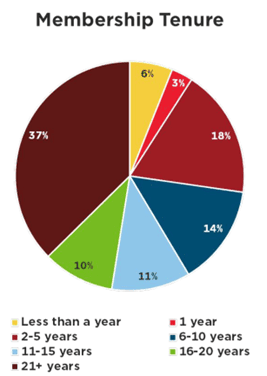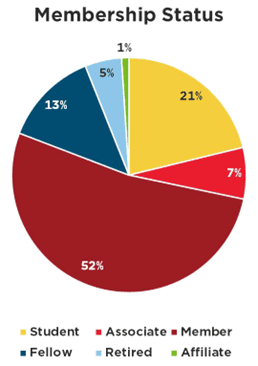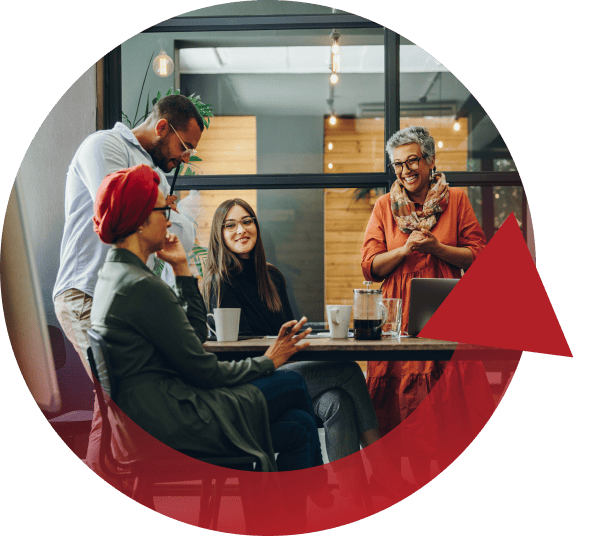Annually, the SIOP Membership Committee Survey Subcommittee conducts a membership survey to evaluate member satisfaction and identify opportunities for improvement to enhance the membership experience. Thank you to those who participated in this year’s survey; your feedback helps ensure SIOP is doing its best to continue serving you, our members and affiliates, to the best of its ability.
This article provides a high-level overview of the results and key themes from the latest membership survey. Many of the findings in this year’s membership survey align with those from the 2024 Exit Survey. All membership surveys can be found here. The Executive Board reviewed the report during its April 2025 meeting.
Participation and Demographics
The following insights are based on responses from approximately 7% of SIOP’s membership (n = 478), out of 6,897 invitations distributed. We saw a drop in participation this year compared to an average of 12–13% participation in prior years. The 2025 Membership Survey was live from January 30 to February 14, 2025. Key demographic breakdowns for the 2025 Membership survey include
- Member type: 52% Members, 21% Students, 13% Fellows, 7% Associates, 5% Retired, 1% Affiliate
- Membership tenure: 37% have been members for 21 or more years, 27% for 5 years or less, 14% for 6–10 years, 11% for 11–15 years, 10% for 16–20 years
- Degree held: 69% PhD, 22% master’s, 6% bachelor’s, 2% PsyD
- Primary employment: 24% external consulting, 23% academic-psychology dept., 18% internal practice-commercial, 11% academic-business dept., 6% internal practice-govt., 5% other, 4% retired, 3% academic-other, 3% internal practice-nonprofit, 3% unemployed
- Veteran status: 92% nonveteran, 6% veteran, 1% active service
- Gender: 52% women; 44% men; 2% prefer not to respond; 1% gender queer, nonbinary, or gender fluid; 1% prefer to self-describe; 1% trans or transgender
- Disability status: 77% no, 17% yes, and 7% prefer not to respond
- Race and ethnicity: 80% White; 9% Asian, 6% Black or African American; 5% prefer not to respond, 4% Hispanic, Latino/a/é or Spanish; 1% Middle Eastern or North African


Key Insights
- Satisfaction has increased by 3% in comparison to 2024, with 76% of members now satisfied with their membership. However, the sizable percentage who neither agreed nor disagreed that they are satisfied (15%) suggests an opportunity for improvement in member satisfaction. Although relatively high, it is the lowest aspect of overall membership engagement (compared to recommendation intentions [82%], pride in SIOP [81%], and membership renewal intentions [88%]).
- Many members take pride in SIOP (81%). They are also willing to recommend SIOP to others (81%) and are committed to the Society (88%); this is a trend that remained high year over year.
- The most room for improvement appeared to be evident in three out of the top six drivers of SIOP engagement. Specifically, satisfaction with available resources (#3 driver) and the perception that diverse opinions are encouraged (#6 driver). To enhance engagement, SIOP could focus on improving benefits and resources by conducting targeted member feedback sessions or benchmarking against other professional organizations.
- SIOP can leverage its existing strengths to further enhance member engagement. Other drivers of engagement include member perceptions about SIOP supporting an environment where everyone is respected (#2 driver), and when there is awareness, members being satisfied with strategic goals and objectives of the organization (#5 driver).
- Only 53% of members are aware of SIOP’s strategic goals and objectives, yet of those who indicated awareness of goals and objectives, 78% express satisfaction with them. This suggests that although members are generally pleased with SIOP’s direction, there is a communication gap in conveying these goals effectively.
- The top two most selected factors for joining or renewing membership with SIOP include attending the SIOP Annual Conference (71%) and connecting with the I-O community (55%), implying that professional connections seem to drive the growth in SIOP membership.
- Satisfaction with resources remained relatively stable (59% in 2025 vs. 60% in 2024), suggesting consistency. Additionally, satisfaction with SIOP benefits compared to other professional organizations dropped to 53%, a 7% decline since 2024. This decline may indicate shifting member expectations or increased competition from other organizations offering more competitive benefits.
- Despite networking being a key factor for membership, opportunities remain to enhance inclusion and community engagement: 52% of members indicate that membership enables connection with communities of interest, 65% feel that SIOP supports an environment where different opinions are valued and encouraged, and 75% agree that SIOP supports an environment where everyone is respected. These lower ratings, combined with high neutral scores (15% or more), highlight key opportunities for improvement in fostering inclusion and community engagement. For instance, to strengthen inclusion and engagement, SIOP could create mentorship programs, discussion forums, or affinity groups tailored to members’ specific interests and for each unique membership group. Some of these already exist (such as the Ambassador program during the annual conference), and marketing these would be useful.
Recommendations Aligned to SIOP Strategic Goals
There are many factors that drive members to join and renew their SIOP membership. Although there are positive sentiments toward the benefits of being part of the SIOP community, few areas exceed 80% positive sentiment, which would typically be considered a threshold for a strength. Additionally, even in areas where members report general satisfaction or relatively higher scores, there are steady declines year over year. Several opportunities identified in this membership survey mirror concerns raised in not only last year’s Membership Survey but also in the recent Exit Survey. These consistent themes and ongoing declines suggest a need for more visible and impactful action. Focused prioritization is needed not only to retain members long term but also to grow SIOP’s membership.
Goal 1: Collaborate with organization leaders, communities, and policymakers to understand and confront relevant real-world problems and translate scientific knowledge to promote individual and organizational health and effectiveness.
I-O in the world: Consistent with last year’s results, the value of I-O psychologists and practitioners is marginally recognized in respondents’ workplaces (57%), and less than a quarter of respondents (15%) indicated that others outside the field understand what they do as an I-O psychologist or practitioner. And although 67% of respondents are satisfied with SIOP’s efforts to promote the field (up 2% since 2024), there is clearly an opportunity to improve awareness and understanding of the field and practitioners’ work beyond the I-O community. Primary themes from the comments analysis for how to improve include the following:
- Increasing transparency of I-O and SIOP: Such as with an improved website (we note that a new version launched in January), greater communication for external awareness and explanation in plain terms
- Enhancing partnerships with other associations: Examples included APA and specific practitioner organizations such as SHRM, ATD, and others
SIOP direction: To effectively promote the field externally, there first needs to be greater clarity internally. Awareness of SIOP’s strategic goals and objectives is relatively low. However, among those who are aware, satisfaction with them is relatively high. There is a significant proportion of members who are neither aware (23%) nor neutral in satisfaction (18%), and 20% who are unaware of the strategic goals and direction. Currently, SIOP is undertaking a review and revision of its strategic goals, and a communication plan will be used to introduce them once they are complete.
Goal 2: Build a diverse, inclusive, and agile SIOP that maximizes our impact through effective people, processes, technology, and data infrastructure.
Inclusive SIOP: The second most selected factor (55%) for joining or renewing SIOP membership is to connect with the I-O community. However, there seem to be some barriers and challenges to facilitating this community connection. For example, only 52% of members indicate that membership actually enables connection with communities of interest or affinity groups. Further, although 75% of participants reported feeling that members treat each other with respect, only 65% reported that SIOP supports an environment where differences of opinion are valued and encouraged. These lower experiences, which continue to decline year over year, coupled with higher neutral scores (15% or more), are indicative of key areas of opportunity for the upcoming year. These are primary themes from comments that relate to helping create a more inclusive environment for members, including
- SIOP in sociopolitical climate: Take stronger or different stances on socially or politically divisive issues, more discussion on current events, and others (feedback here would also be relevant to helping SIOP be more relevant in advocacy beyond SIOP’s four walls, such as highlighting the work in Washington Info-Goal #1)
- Engagement: Better understanding of ways to get involved, improvements needed in service requirements, and participation in committees are the most valuable ways to engage in SIOP
- Relationships: Networking, mentoring, community building, and other ways to create more meaningful relationships
Benefits and resources: Satisfaction with the benefits of SIOP (compared to other professional organizations) and satisfaction with the resources available through SIOP are important to members, yet consistently associated with lower levels of satisfaction (53% and 59%, respectively). Satisfaction with benefits compared to other organizations saw a 7% decrease since 2024, suggesting a greater need to focus here.
In response to the question, What resources would be valuable to SIOP members?, 130 respondents provided insights. Themes included I-O journal access (23 comments), whitepapers (4 comments), improved job boards (18 comments), practitioner forums (10 comments), training (11 comments), teaching resources (6 comments), and others. Themes from other qualitative questions from the survey indicated additional development options, such as access to new publications (e.g., HBR, Psych Today, etc.), and others.
SIOP staff support: In the past year, 47% of members (212 of the 454 who answered the question) interacted with SIOP staff, and 79% indicated being satisfied with the level of support provided. Of the comments provided, nearly two thirds provide satisfaction related to the overall helpfulness of staff, mentioning specific individuals, professionalism, responsiveness, and so forth. The other third of comments were dissatisfied with their interactions, with themes such as navigating confusing processes to get to staff, staff not having knowledge to help, overall lack of support, unprofessional interactions, navigating bureaucracy, and others.
Goal 3: Use and strengthen our ability to gather, energize, and align all those invested in understanding and improving work and workplace issues in ways that inspire action and inclusive dialogue.
I-O community connections: The top two reasons why members join or renew their membership are for the SIOP Annual Conference and connecting with the I-O community. However, there seem to be some barriers to building or regularly participating in the community. When asked about participation in local I-O group events, 19% participated, 50% responded that they did not participate, and 22% indicated the question was not applicable. Additionally, only 46% agreed that SIOP allows them to connect with communities of interest or affinity groups. Comments indicated that the absence of many local groups, lack of funding support, and challenges connecting with communities of interest are barriers to maintaining the I-O community connection beyond the annual conference. Additionally, there is a greater need to have a stronger practitioner focus within SIOP, as it is perceived to be too academically focused, which contributes to a sense of elitism. This is a clear opportunity, coupled with building on a strong foundation of a more inclusive SIOP, as mentioned above.
Goal 4: Create an ecosystem that generates future I-O psychology capabilities to advance and advocate for both science and practice by guiding education and lifelong learning.
Value of membership: Members agree that SIOP membership is critical for those studying and practicing I-O psychology (72%). However, as previously noted, given that satisfaction with benefits compared to other organizations and resources is down, there is work to be done to ensure that membership in SIOP is seen as a valuable investment in their careers long term. This is also critically important when members aren’t receiving as much financial support from employers/schools for their membership fees (only 43% pay for some part), conference registrations (only 62% pay for some), and/or webinar registrations (only 26% pay). Similar to the last Exit Survey comments, respondents feel that membership has become too expensive for the value they receive and offer ideas of varying cost structures to alleviate the burden and enhance value. Many members do not understand what their membership fee buys them.
Credentialing talks: When asked about licensure, 8% of members are licensed in a state, province, or country; 15% are not but would be interested in licensure; 72% are not licensed and are uninterested in licensure. However, when asked about a new I-O credential being developed, 57% expressed they would be interested in participating in the application for competency assessment. For the 32% not interested, the most commonly selected response (81%) felt it would not enhance their credibility.
SIOP learning offerings: 33% of members indicated participation in Preconference Workshops and Friday Seminars that are part of the conference “some years”; 56% indicated never. Outside of the annual conference or the Leading Edge Consortium, members don’t typically participate in many other learning opportunities offered through SIOP, 65% indicating never and 22% indicating some years.
The top five characteristics members value the most in learning program content are connection and networking opportunities (65%), the expertise of speakers (59%), virtual delivery (47%), delivery aligned with a conference event they’re already attending (32%), and a high level of interaction during the program (29%).
Final Thoughts
There are strong foundations to build upon with regard to the current SIOP membership; from those who responded, general engagement is high, and members feel respected. Yet, there continue to be consistent themes year after year where members voice opportunities for improvement. Further, many of the themes found in the 2025 Membership Survey echo those reported from the 2024 Membership Survey and the most recent Exit Survey, further supporting a much more drastic call to action upon SIOP leadership. More meaningful action is needed to address these key areas.
- Overall value of membership, including the cost, benefits and resources received in return
- Building a more inclusive environment, where practitioners feel more welcomed and supported, the elitism is addressed, a broadening of voices and perspectives is equally valued and actively sought, and more effort is channeled to support local I-O communities
- Broadening development opportunities to ensure that experience and expertise is behind the offerings, a breadth of offerings are available across modalities, and cater to the breadth of membership and types of roles beyond the breakdown of academic versus practitioner
- Partnership with other organizations— SIOP has an opportunity to partner more, not only with practitioner organizations and APA, but with other I-O communities globally as the largest I-O community globally
Foremost, if SIOP and I-O psychologists are to continue to shape the world of work, our community should similarly strive for continuous improvement. More support is needed for the growth, development, community, and connection among I-O psychologists.
Volume
63
Number
2
Author
Liz Pavese, Courtney Baker, Rob Calderon, Michael Horvath, Rushika De Bruin, Erin Schemmel, and Gina Thoebes
Topic
Membership

